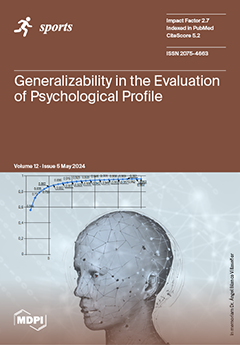The aims of this study were to analyze the effects of a congested period (three games in four days) on countermovement (CMJ) jump-landing metrics, heart rate variability (HRV), and total recovery quality (TQR) score in under-19 male futsal players, and to detect the
[...] Read more.
The aims of this study were to analyze the effects of a congested period (three games in four days) on countermovement (CMJ) jump-landing metrics, heart rate variability (HRV), and total recovery quality (TQR) score in under-19 male futsal players, and to detect the differences between those who played for more minutes (HIGH
MIN) and less minutes (LOW
MIN). Fourteen youth futsal players (age: 17.5 ± 0.5 years; body mass: 70.2 ± 8.5 kg; height: 1.80 ± 0.1 m) participated. HRV, TQR questionnaire, and CMJ metrics (i.e., CMJ height, relative peak power (PP
REL), eccentric and concentric impulse, braking time, and time to peak force) were registered. A linear mixed model and effect sizes (ESs) were used to assess the differences between groups and days. Considering the total sample, a significant decrease was found in the PP
REL and TQR score (
p = 0.001–0.013 and ES = 0.28–0.99) on Days 2, 3, and 4 when compared to Day 1. HIGH
MIN group presented a significant decrease in PP
REL on Day 3 (
p = 0.004; ES: 0.62; 95% CI: 0.39–2.65) when compared to Day 1, and in the TRQ score on Day 3 (
p = 0.002; ES: 1.98; 95% CI: 0.18–2.46) and 4 (
p = 0.003; ES: 2.25; 95% CI: 0.52–3.38) when compared to Day 1. Non-significant differences were found for the rest of the metrics and in the group LOW
MIN. In summary, neuromuscular performance (i.e., CMJ PP
REL) and subjective recovery were impaired in players with higher playing minutes during a match-congested period when compared to those with less on-court time.
Full article






